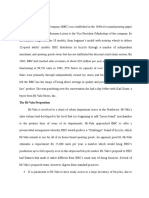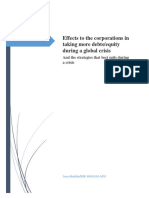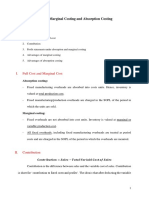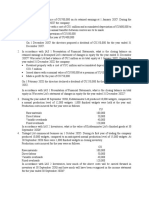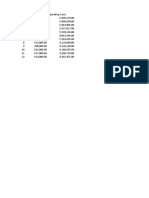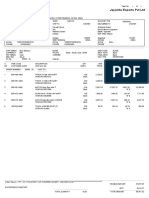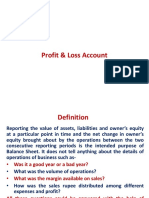3 - Cost Volume Profit Analysis
3 - Cost Volume Profit Analysis
Uploaded by
PattraniteCopyright:
Available Formats
3 - Cost Volume Profit Analysis
3 - Cost Volume Profit Analysis
Uploaded by
PattraniteOriginal Title
Copyright
Available Formats
Share this document
Did you find this document useful?
Is this content inappropriate?
Copyright:
Available Formats
3 - Cost Volume Profit Analysis
3 - Cost Volume Profit Analysis
Uploaded by
PattraniteCopyright:
Available Formats
CHAPTER THREE: COST-VOLUME-PROFIT ANALYSIS
Cost-volume-profit analysis studies the relations among revenues, cost, and volume and their effect on profit.
The key relation for CVP analysis is the profit equation.
Total contribution margin is the amount that units sold contribute toward (1) covering fixed costs and (2) providing
operating profits.
Contribution margin ratio is the contribution margin as a percentage of sales revenue.
Profit-volume analysis is version of CVP analysis which uses a single profit line.
Cost structure is the proportion of fixed and variable costs to the total costs of an organization.
Operating leverage is the extent to which an organization’s cost structure is made up of fixed costs.
The margin of safety is the excess of projected (actual) sales over the break-even sales level.
Operating profit= Total revenues – Total costs
Total revenue= Price * Units of output produced and sold
Total costs= (Variable costs per unit * units of output) + Fixed costs
Or… Profit= (Price- Variable costs) * Units of output – Fixed costs
Contribution margin = Selling price – Variable costs
¿ costs
Breakeven volume ( ¿ units )=
Unit contribution margin
Unit contributionmargin
Contribution margin ratio=
Sales revenue
¿ costs
Breakeven volume ( ¿ sales dollars )=
Contribution margin ratio
¿ costs+Target profit
Target volume ( ¿ units )=
Contribution margin per unit
¿ costs+Target profit
Target volume ( ¿ units )=
Contribution marginratio
Contribution margin
Operating leverage=
Operating profit
Margin of safety=Sales volume−Break even sales volume
After-tax profit= [(P-V)X – F] * (1- t)
target profit
¿ costs+[ ]
(1−t )
Target volume ( ¿ units )=
Contribution marginratio
You might also like
- Contracts Outline BurtonDocument28 pagesContracts Outline BurtonAnna DeWallNo ratings yet
- Chapter 8 Assignment AnswersDocument20 pagesChapter 8 Assignment AnswersPattraniteNo ratings yet
- Baldwin Bicycle Analysis (ImranGreenSlide)Document20 pagesBaldwin Bicycle Analysis (ImranGreenSlide)Azuwan KhalidiNo ratings yet
- Foreign Currency TranslationDocument38 pagesForeign Currency TranslationAnmol Gulati100% (1)
- CFi Capital Structure Leverage ProblemsDocument6 pagesCFi Capital Structure Leverage ProblemsJustin Russo HarryNo ratings yet
- Chapter 3 AnswersDocument47 pagesChapter 3 AnswersPattranite100% (1)
- CH 10 GREE Case StudyDocument15 pagesCH 10 GREE Case StudyPriyanka PiaNo ratings yet
- Pet Industry PDFDocument12 pagesPet Industry PDFmail meNo ratings yet
- Amity MBA CRM Module 1Document102 pagesAmity MBA CRM Module 1vikrant100% (1)
- Deed of SaleDocument4 pagesDeed of SaleAngelo Lopez67% (3)
- Terry Manning Fashion Center SolvedDocument6 pagesTerry Manning Fashion Center SolvedMenxie Millano Lim0% (1)
- Managerial Accounting FormulasDocument6 pagesManagerial Accounting FormulasKristine Esplana ToraldeNo ratings yet
- Consolidated Financial StatementsDocument7 pagesConsolidated Financial StatementsParvez NahidNo ratings yet
- 6 - Dividend - DividendPolicy - FM - Mahesh MeenaDocument9 pages6 - Dividend - DividendPolicy - FM - Mahesh MeenaIshvinder SinghNo ratings yet
- Chapter 5 PDFDocument71 pagesChapter 5 PDFSyed Atiq TurabiNo ratings yet
- Managerial Accounting-Solutions To Ch09Document16 pagesManagerial Accounting-Solutions To Ch09Mohammed Hassan100% (1)
- COM670 Chapter 5Document19 pagesCOM670 Chapter 5aakapsNo ratings yet
- F2-08 Absorption and Marginal CostingDocument16 pagesF2-08 Absorption and Marginal CostingJaved ImranNo ratings yet
- FM PPT Ratio AnalysisDocument12 pagesFM PPT Ratio AnalysisHarsh ManotNo ratings yet
- Marginal and Absorption CostingDocument4 pagesMarginal and Absorption CostingNabeel Ismail/GDT/BCR/SG4No ratings yet
- Currency FuturesDocument11 pagesCurrency FuturesAakash ChhariaNo ratings yet
- Audit Reports: ©2006 Prentice Hall Business Publishing, Auditing 11/e, Arens/Beasley/ElderDocument42 pagesAudit Reports: ©2006 Prentice Hall Business Publishing, Auditing 11/e, Arens/Beasley/ElderJohn BryanNo ratings yet
- Financial Management Test 2: Answer ALL QuestionsDocument3 pagesFinancial Management Test 2: Answer ALL Questionshemavathy50% (2)
- 0462Document277 pages0462Tahseen Raza100% (1)
- Corporate Finance Model AnswerDocument3 pagesCorporate Finance Model AnswersrikanthNo ratings yet
- Problem Solving 16Document11 pagesProblem Solving 16Ehab M. Abdel HadyNo ratings yet
- Management AccountingDocument54 pagesManagement AccountingjibharatNo ratings yet
- Pages From MCOM-Ac - Paper - II PDFDocument64 pagesPages From MCOM-Ac - Paper - II PDFPravesh Kumar SinghNo ratings yet
- Capital Structure.Document22 pagesCapital Structure.Puneet ShirahattiNo ratings yet
- FSA 8e Ch07 SMDocument60 pagesFSA 8e Ch07 SMdesy nataNo ratings yet
- MA2 (100 QS)Document30 pagesMA2 (100 QS)Alina NaeemNo ratings yet
- PPT3-Consolidated Financial Statement - Date of AcquisitionDocument54 pagesPPT3-Consolidated Financial Statement - Date of AcquisitionRifdah Saphira100% (1)
- Inflation AccountingDocument18 pagesInflation AccountingArun Pandey100% (1)
- Portfolio Theory 2Document65 pagesPortfolio Theory 2Kevin NamiNo ratings yet
- Chapter 15Document20 pagesChapter 15sdfklmjsdlklskfjdNo ratings yet
- Chapter 4 Exercises 1-8Document9 pagesChapter 4 Exercises 1-8deniz turkbayragiNo ratings yet
- Revision Pack 4 May 2011Document27 pagesRevision Pack 4 May 2011Lim Hui SinNo ratings yet
- Cost-Volume-Profit Relationships: Solutions To QuestionsDocument106 pagesCost-Volume-Profit Relationships: Solutions To QuestionsAbene Man Wt BreNo ratings yet
- GE PPT Ch13 Lecture 2 Pricing Decisions & Cost ControlDocument53 pagesGE PPT Ch13 Lecture 2 Pricing Decisions & Cost ControlZoe Chan100% (1)
- Corporate Finance Assignment PDFDocument13 pagesCorporate Finance Assignment PDFسنا عبداللهNo ratings yet
- Overview of Financial ManagementDocument16 pagesOverview of Financial ManagementKAUSHIKNo ratings yet
- Fa - 6 Amalgamation & LLPDocument10 pagesFa - 6 Amalgamation & LLPalokchowdhury111No ratings yet
- BFC5935 - Tutorial 4 SolutionsDocument6 pagesBFC5935 - Tutorial 4 SolutionsXue XuNo ratings yet
- Chapter 3Document30 pagesChapter 3Varun ChauhanNo ratings yet
- Practice Sheet 4 - CH5 SolutionDocument8 pagesPractice Sheet 4 - CH5 SolutionAhmed HyderNo ratings yet
- Unit 6 - Capital Structure and LeverageDocument12 pagesUnit 6 - Capital Structure and LeverageGizaw BelayNo ratings yet
- Cost of CapitalDocument4 pagesCost of Capitalkomal mishraNo ratings yet
- Risk and Return: Answers To End-Of-Chapter QuestionsDocument26 pagesRisk and Return: Answers To End-Of-Chapter QuestionsMuhammad ZafarNo ratings yet
- Absorption and Variable CostingDocument6 pagesAbsorption and Variable CostingEvangelista, Trisha Gael V.100% (1)
- Throughput AccountingDocument12 pagesThroughput AccountingSaqib Akhtar100% (3)
- Cost 2021-MayDocument8 pagesCost 2021-MayDAVID I MUSHINo ratings yet
- Chapter 9 Marginal Costing and Absorption CostingDocument7 pagesChapter 9 Marginal Costing and Absorption CostingLinyVatNo ratings yet
- Growth of Corporation Occurs Through 1. Internal Expansion That Is Growth 2. MergersDocument8 pagesGrowth of Corporation Occurs Through 1. Internal Expansion That Is Growth 2. MergersFazul Rehman100% (1)
- Investment Analysis CODocument4 pagesInvestment Analysis COMIKIYAS BERHENo ratings yet
- Midterm 5101Document4 pagesMidterm 5101MD Hafizul Islam HafizNo ratings yet
- MAC Summary of FormulasDocument25 pagesMAC Summary of FormulasRuNo ratings yet
- ACC 121 Chapter 1 Exercise SolutionsDocument12 pagesACC 121 Chapter 1 Exercise SolutionsDarrianAustinNo ratings yet
- Time Value of MoneyDocument52 pagesTime Value of MoneyJasmine Lailani ChulipaNo ratings yet
- Chapter 10 Translation ExposureDocument14 pagesChapter 10 Translation ExposurehazelNo ratings yet
- Cost and Management Accounting - Course OutlineDocument9 pagesCost and Management Accounting - Course OutlineJajJay100% (1)
- Chapter 6 Discounted Cash Flow ValuationDocument27 pagesChapter 6 Discounted Cash Flow ValuationAhmed Fathelbab100% (1)
- Decoding DCF: A Beginner's Guide to Discounted Cash Flow AnalysisFrom EverandDecoding DCF: A Beginner's Guide to Discounted Cash Flow AnalysisNo ratings yet
- Value Chain Management Capability A Complete Guide - 2020 EditionFrom EverandValue Chain Management Capability A Complete Guide - 2020 EditionNo ratings yet
- CVP Formula SheetDocument1 pageCVP Formula SheetMacronNo ratings yet
- Managerial Accounting FormulasDocument6 pagesManagerial Accounting FormulasKimberly ToraldeNo ratings yet
- Ch. 1 - FormulaDocument3 pagesCh. 1 - FormulaKen KensNo ratings yet
- CVP AnalysisDocument1 pageCVP AnalysisRose Ann GarciaNo ratings yet
- Intermediate Accounting Chapter 3 ProblemsDocument34 pagesIntermediate Accounting Chapter 3 ProblemsPattraniteNo ratings yet
- Chapter 5 Assignment Regression AnalysisDocument7 pagesChapter 5 Assignment Regression AnalysisPattraniteNo ratings yet
- Chapter 13 AnswersDocument47 pagesChapter 13 AnswersPattraniteNo ratings yet
- Chapter 5 AnswersDocument49 pagesChapter 5 AnswersPattraniteNo ratings yet
- 2 - Cost Concepts and BehaviorDocument3 pages2 - Cost Concepts and BehaviorPattraniteNo ratings yet
- Chapter 4 AnswersDocument63 pagesChapter 4 AnswersPattranite100% (1)
- 4 - Cost Analysis For Decision MakingDocument2 pages4 - Cost Analysis For Decision MakingPattraniteNo ratings yet
- Work It!: Stretching and Zumba ExercisesDocument2 pagesWork It!: Stretching and Zumba ExercisesPattraniteNo ratings yet
- Chapter Five: Cost Estimation: Total CostsDocument2 pagesChapter Five: Cost Estimation: Total CostsPattraniteNo ratings yet
- Chapter Seven - Process Selection, Design, and ImprovementDocument3 pagesChapter Seven - Process Selection, Design, and ImprovementPattraniteNo ratings yet
- Chapter 11 SampleDocument6 pagesChapter 11 SamplePattraniteNo ratings yet
- Chapter Six - Supply Chain DesignDocument3 pagesChapter Six - Supply Chain DesignPattraniteNo ratings yet
- CHAPTER THREE - Operations ManagementDocument1 pageCHAPTER THREE - Operations ManagementPattraniteNo ratings yet
- LevisDocument55 pagesLevisVivek Nair0% (1)
- Villa V Garcia BosqueDocument1 pageVilla V Garcia BosqueAices SalvadorNo ratings yet
- Analyze The Gardenia in Porter Five Competitive ForcesDocument7 pagesAnalyze The Gardenia in Porter Five Competitive ForcesChesca AlonNo ratings yet
- CH 15 SlidesDocument15 pagesCH 15 SlidesKhanHeenaNo ratings yet
- Liquidity RatioDocument7 pagesLiquidity Ratioanon_41439843No ratings yet
- Jayanita Exports PVT LTD GST InvoiceDocument3 pagesJayanita Exports PVT LTD GST InvoiceMITHUN BERANo ratings yet
- Danvillle Maritime Inc vs. COA, 175, SCRA 701Document2 pagesDanvillle Maritime Inc vs. COA, 175, SCRA 701Anonymous 8SgE99No ratings yet
- Profit & Loss AccountDocument12 pagesProfit & Loss AccountSubhadeeptaSahooNo ratings yet
- ch18 (16th)Document115 pagesch18 (16th)mutiara 322016079100% (10)
- Qatar Duty FreeDocument3 pagesQatar Duty FreerazanymNo ratings yet
- Coca - Cola Pepsi Critical Success Factors Weight Rating Weight Score RatingDocument6 pagesCoca - Cola Pepsi Critical Success Factors Weight Rating Weight Score RatingFaisal RafiqNo ratings yet
- Selective ControlDocument5 pagesSelective ControlPinak ShomeNo ratings yet
- International Strategy: Dosen: Tri DjatmikoDocument14 pagesInternational Strategy: Dosen: Tri DjatmikoHaryaman JustisiaNo ratings yet
- Mars-Wrigley Deal 1Document8 pagesMars-Wrigley Deal 1Narain KishoreNo ratings yet
- How To Renew Your Car's Fahas and Istimara (Vehicle - Car Registration) in Riyadh, Saudi Arabia - Step by Step Guide (Updated)Document4 pagesHow To Renew Your Car's Fahas and Istimara (Vehicle - Car Registration) in Riyadh, Saudi Arabia - Step by Step Guide (Updated)terramocoNo ratings yet
- Completing The Cost Cycle and Accounting For Production and LossesDocument31 pagesCompleting The Cost Cycle and Accounting For Production and LossesAllysa OleaNo ratings yet
- Business Math - Q1 - Week 6 - Module 4 - MARGINS AND DISCOUNTS REPRODUCTIONDocument20 pagesBusiness Math - Q1 - Week 6 - Module 4 - MARGINS AND DISCOUNTS REPRODUCTIONJhudiel Dela ConcepcionNo ratings yet
- India Localization Inter Org TransferDocument33 pagesIndia Localization Inter Org TransferSanthosh KumarNo ratings yet
- Penarth Classified Adverts 111214Document3 pagesPenarth Classified Adverts 111214Digital MediaNo ratings yet
- Pro-Grip MAX - How To Order: 5 Air Cooled Cable TerminationsDocument1 pagePro-Grip MAX - How To Order: 5 Air Cooled Cable TerminationsHoque AnamulNo ratings yet
- Questions With AnswersDocument21 pagesQuestions With AnswersZzaza OppNo ratings yet
- Sadman - BritanniaDocument3 pagesSadman - BritanniaUpasana GhoshNo ratings yet
- Assignment No. 6Document14 pagesAssignment No. 6Angela MacailaoNo ratings yet


